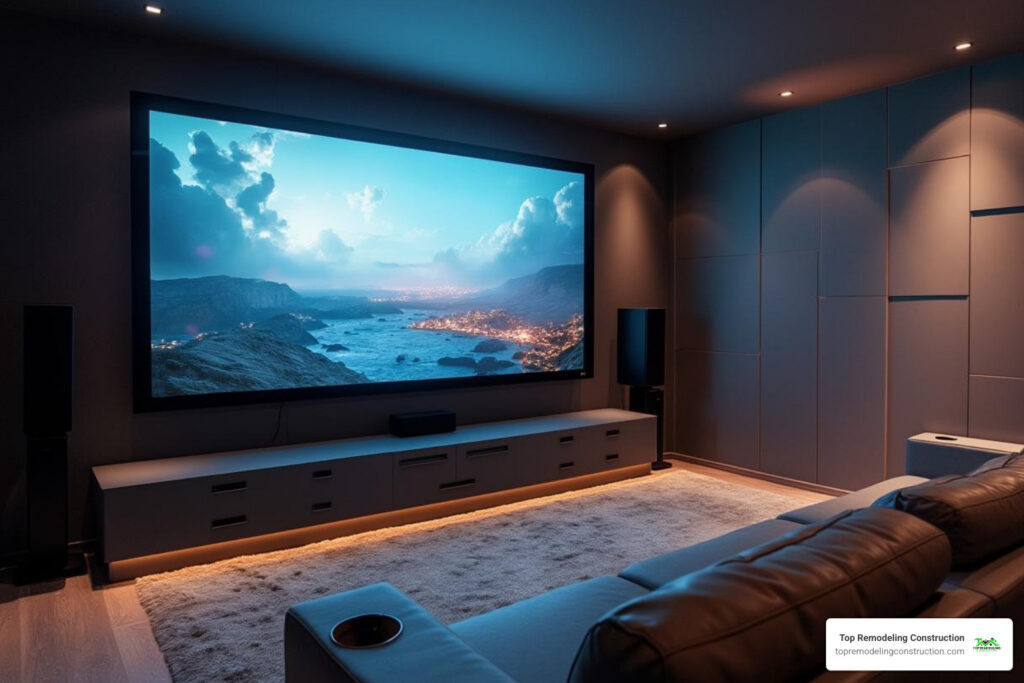Why Home Theater Installation is Worth the Investment
Home theater installation transforms your house into a personal entertainment destination that delivers cinema-quality experiences without leaving home. Whether you’re upgrading from a basic TV setup or building a dedicated theater room, professional installation ensures optimal performance and long-term value.
Quick Answer for Home Theater Installation:
- Average Cost: $17,500 (range: $2,000-$63,000)
- Key Components: Display/projector, surround sound system, seating, lighting control
- Best Locations: Basement (ideal), dedicated room, or living room conversion
- ROI: Approximately 65% return on investment
- Professional vs DIY: Complex wiring and calibration typically require professional expertise
Home theaters have become increasingly popular as homeowners seek premium entertainment experiences at home. This investment isn’t just about entertainment – it’s about creating a space that adds genuine value to your property.
Key considerations include:
- Room Selection – Basements offer ideal light control and sound isolation
- Component Matching – Properly sized screens, speakers, and amplifiers for your space
- Professional Installation – Ensures safety, optimal performance, and warranty coverage
- Ongoing Support – Calibration, updates, and maintenance keep your system performing
Basic home theater installation vocab:
– flooring installation specialists
– home builder and renovation
– remodeling construction company
Understanding Home Theater Installation Basics
Home theater installation fundamentals center around sound and display systems working together. A 5.1 system uses five speakers plus one subwoofer, while 7.1 systems add two more speakers for richer sound. Dolby Atmos adds overhead speakers for three-dimensional audio that puts you inside the action.
Display choices dramatically impact your experience. Quality 4K TVs in the 50-60 inch range cost $800-$1,500 and work perfectly for most rooms. Projectors create massive 100+ inch images starting around $1,500 for basic models, with premium options reaching $60,000.
Wiring infrastructure serves as your theater’s nervous system. Professional installations require dedicated electrical circuits, structured cabling, and proper ventilation to keep everything running smoothly.
Acoustics matter more than expensive equipment. A moderately priced system in a well-designed room sounds infinitely better than premium speakers in a space with poor acoustics.
What Does a Full Home Theater Installation Include?
Display options form the visual foundation, whether large TV or projector setup. Professional installation ensures optimal viewing angles and calibration.
Surround speakers create immersive audio through in-wall speakers, ceiling-mounted options, or traditional floor-standing models. Subwoofers handle deep bass for visceral experiences.
The AV receiver serves as mission control, managing inputs and processing audio formats. Remote control systems have evolved to smartphone apps controlling lighting, temperature, and all entertainment sources.
Home Theater Installation Safety & Pre-Wiring Tips
Electrical work must meet local building codes, especially dedicated circuits for high-powered amplifiers. Cable management prevents fire hazards and electromagnetic interference.
Pre-wiring during construction offers invisible, professional results including speaker cables, dedicated electrical circuits, network connectivity, and equipment storage with proper ventilation.
Planning Your Perfect Theater Space
Choosing the right location makes or breaks your home theater installation. Basements are ideal because they naturally block outside light and contain sound better than any other room. However, budget an extra $2,000 to $5,000 for proper moisture control, insulation, and HVAC work.
Living room theaters offer flexibility for family use but require excellent window treatments to control ambient light. Attic spaces provide cozy media rooms with natural separation but need temperature management solutions.
| Location | Light Control | Sound Isolation | Cost Impact | Best For |
|---|---|---|---|---|
| Basement | Excellent | Excellent | Medium | Dedicated theaters |
| Attic | Good | Good | High | Small media rooms |
| Living Room | Challenging | Poor | Low | Multi-purpose spaces |
Choosing the Right Screen Size for Your Room
The viewing distance rule is your best friend. Minimum viewing distance should equal screen width times two. Maximum distance equals screen width times five. For a 100-inch diagonal screen (87 inches wide), you need seating between 14.5 and 36 feet away.
Screen gain affects brightness and viewing angles. Higher gain screens (1.3 to 1.8) help in rooms with ambient light but may create hot spots for side seating.
Optimal Speaker Layouts: 5.1, 7.1, 7.1.4
5.1 systems provide front left/right speakers, center channel, two surrounds, and one subwoofer. 7.1 systems add rear surrounds for larger rooms over 15 by 20 feet.
7.1.4 Dolby Atmos systems add four height channels for three-dimensional sound. Two properly calibrated subwoofers often outperform one expensive unit.
Projector Placement Best Practices
Throw distance calculations must account for your projector’s lens characteristics and room limitations. Ceiling mounting provides the cleanest installation with adjustable mounts for fine-tuning.
Heat management affects projector longevity through adequate ventilation and cooling systems.
Quality speakers like Bowers & Wilkins speakers demonstrate why professional installation matters.
For comprehensive planning, explore our home remodeling services.
Selecting Components & Layout that Fit Your Budget
With the average home theater installation running $17,500, smart budget allocation is crucial. Roughly 40% goes to equipment, 35% covers professional labor at $60-$80 per hour, 15% handles infrastructure, and 10% covers finishing touches.
Display choices dramatically impact investment. Quality 4K TVs cost $800-$1,500, mid-range options run $2,000-$5,000, while premium projector systems reach $10,000-$60,000.
Audio systems follow similar patterns. Basic 5.1 systems cost $1,500-$3,000, advanced 7.1 setups run $4,000-$8,000, while reference-quality 7.1.4 systems start around $10,000.
Theater seating ranges from $500 per seat for basic options to $2,000+ for premium power recline with USB ports.
Balancing Cost vs Performance in Home Theater Installation
The 40-30-20-10 split works well: 40% on speakers/amplification, 30% on display, 20% on installation/infrastructure, and 10% on accessories.
A $5,000 system professionally installed often outperforms a poorly configured $10,000 system. Planning for upgrades saves money – start with quality 5.1 while pre-wiring for 7.1.4 expansion.
Resale value typically recovers about 65% of installation costs for well-executed installations in appropriate spaces.
Future-Proofing Your System for New Technologies
HDMI 2.1 capability ensures 4K content at 120Hz refresh rates. Streaming integration needs robust networking for multiple 4K streams.
Voice control through Alexa, Google Assistant, or Apple HomeKit adds convenience. Regular maintenance keeps systems current with firmware updates.
For comprehensive renovation services, check our home remodeling services.
Hiring the Right Home Theater Installation Services
Choosing the right installer transforms expensive equipment into magical experiences. Professional installers bring proper licensing and insurance coverage (minimum $1 million recommended), specialized acoustic measurement tools, and industry certifications.
Professional installers use sophisticated tools like REW (Room EQ Wizard) and calibrated microphones to optimize performance. They understand speaker placement, room acoustics, and system integration.
DIY makes sense for simple TV mounting or basic soundbar connections. But electrical circuits, in-wall wiring, or multi-channel calibration requires professional expertise.
Look for CEDIA certification and manufacturer certifications. Insurance coverage protects everyone – reputable companies provide certificates when requested.
Red Flags & Common Mistakes to Avoid in Home Theater Installation
Quotes that seem too good to be true usually are. Quality installation takes time, skill, and proper materials.
Watch for contractors who won’t provide references or seem evasive about insurance. Poor speaker angles, under-powered subwoofers, and wrong screen sizing create expensive disappointments.
Poor cable management creates safety hazards, while inadequate ventilation leads to equipment failure.
Questions to Ask Before Signing a Contract
Ask about technical qualifications and certifications. Get specific about project scope and timeline. Understand warranty and support policies.
Confirm business basics – licensing, insurance, payment schedules, and permit handling.
Professional installers welcome these questions. You can Book a Free Site Survey Here to get started with experienced professionals.
Cost, Value & Ongoing Support
The $17,500 average home theater installation cost breaks down logically: equipment takes 40% ($7,000), professional labor 35% ($6,125), infrastructure 15% ($2,625), and accessories 10% ($1,750).
That 65% return on investment reflects real market data, though actual returns depend on integration with your home’s design and local market preferences.
Annual calibration services typically cost $200-$500 but protect your investment as rooms change over time.
Is a Home Theater a Good Investment for Your Home?
Absolutely. A family spending $60 on movies every other week racks up $1,500 annually. Your home theater pays for itself while delivering superior experiences.
Lifestyle benefits often outweigh financial ones – you control everything from temperature to volume. Modern equipment brings energy efficiency too.
Buyers increasingly value home entertainment features, especially after recent years highlighted comfortable home spaces.
Affordable Packages & Financing Options
Entry-level systems ($5,000-$8,000) deliver impressive results with 65-inch 4K TVs and quality 5.1 surround.
Mid-range installations ($10,000-$15,000) step up to projector systems with 7.1 surround and automated lighting.
Premium systems above $20,000 bring full cinema experiences with high-end projectors and Dolby Atmos.
Financing options include manufacturer programs, home equity loans, and strategic credit card promotions. DIY-hybrid approaches save money while maintaining quality.
At Top Remodeling Construction, we work with you to find solutions fitting your budget while delivering the entertainment experience you’re dreaming of.
Frequently Asked Questions about Home Theater Installation
How much space do I really need?
For TV-based systems, a 12×12-foot room works perfectly with a 65-inch display. Projector setups need 16-20 feet minimum for 100-inch screens.
Ceiling height plays a bigger role than expected. Standard 8-foot ceilings work fine, but 9-10 foot ceilings offer better speaker placement options.
Width matters for surround sound – allow at least 3 feet on each side of seating for proper speaker positioning.
Can I start small and expand later?
Absolutely! Smart home theater installation planning means starting within budget and building over time.
Pre-wiring is your best friend – running speaker wire during construction costs a fraction of retrofitting later. Many families start with quality 5.1 systems, then add extra speakers for 7.1, then Dolby Atmos height channels.
Professional installers create expansion roadmaps showing exactly how systems can grow while ensuring compatibility.
Should I calibrate audio & video annually?
Your system doesn’t need professional calibration every year, but benefits from regular attention. Room changes trigger recalibration needs more than calendar dates.
Modern AV receivers include automatic calibration systems handling basic optimization. Running these every six months keeps most systems performing well.
Professional calibration becomes valuable for advanced optimization addressing complex acoustic issues. A practical schedule includes annual health checks with professional calibration every 2-3 years.
Conclusion
Your home theater installation journey becomes manageable with the right professional team. The 65% return on investment and $17,500 average cost tell part of the story, but real value lies in family movie nights where everyone wants to stay home.
Your next steps start with honest assessment of your space and budget. Whether it’s that basement conversion or living room upgrade, working with professionals who understand how families actually live makes all the difference.
At Top Remodeling Construction, we bring Las Vegas construction expertise to every theater project. We understand your home is where life happens, handling the technical complexity while you imagine the results.
Quality installation pays for itself through years of reliable performance. When properly designed and installed, weekend movie marathons become family traditions instead of troubleshooting sessions.
Our comprehensive home remodeling services can integrate your home theater installation into broader home improvement projects, creating spaces that work beautifully together. Let’s turn your entertainment dreams into reality that makes coming home the best part of every day.








